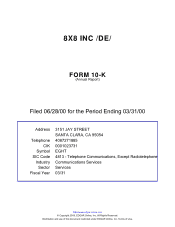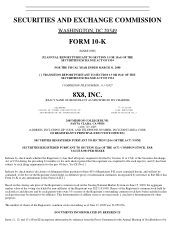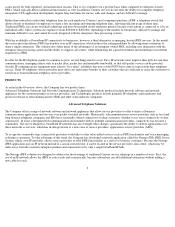8x8 2000 Annual Report Download - page 9
Download and view the complete annual report
Please find page 9 of the 2000 8x8 annual report below. You can navigate through the pages in the report by either clicking on the pages listed below, or by using the keyword search tool below to find specific information within the annual report.scales poorly for both regulatory and architectural reasons. That is, it is expensive on a per line basis when compared to enterprise-owned
PBXs, which typically deliver additional functionality as well. In addition, Centrex services do not offer the ability for computer telephony
integration (CTI) application development, require long lead times for moves, adds and changes, and are difficult to manage.
Rather than subscribe to individual telephone lines for each employee (Centrex), most companies purchase a PBX, a telephone switch that
allows dozens or hundreds of employees to share a few incoming and outgoing telephone lines, allowing efficient usage of those lines.
Traditional PBXs use circuit-switched technology and must be installed on the enterprise premise because every phone is connected to it by an
individual cable. These systems are expensive (from $20,000 to $200,000, depending on the number of extensions), difficult to manage and
maintain, difficult to use, and cannot be easily integrated with the enterprise's data processing systems.
With the availability of broadband IP connectivity to businesses, however, a third alternative is emerging: hosted iPBX services. In this model,
the service provider delivers PBX functionality over an IP connection, which reduces the scaling problems by allowing many extensions to
share a single connection. This solution also offers many of the advantages of an enterprise-owned PBX, including easy integration with the
enterprise data processing system and the ability to support call centers, while eliminating the capital investment and maintenance investment
required for a PBX.
In order for the IP telephony market to continue to grow, several things need to occur. First, IP networks must improve their QoS for real-time
communications, managing effects such as packet jitter, packet loss and unreliable bandwidth, so that toll-quality service can be provided.
Second, IP communications equipment must achieve "five-nines" reliability that users of the PSTN have come to expect from their telephone
service. Third, IP telephone service providers must offer cost and feature benefits to their customers that are sufficient to cause the customers to
switch away from traditional telephony service providers.
PRODUCTS
As noted in the Overview, above, the Company has two product lines:
Advanced Telephony Solutions and Network Communication Technologies. Solutions products include network software and network
appliances for the customer premise to service providers, and Technologies products include primarily IP telephony semiconductors and
protocol software to telecommunications OEMs and other semiconductor companies.
Advanced Telephony Solutions
The Company offers a range of network software and network appliances that allow service providers to offer a variety of business
communications applications and services over packet switched networks. Historically, telecommunications service providers such as local and
long distance telephone companies and ISPs have essentially offered connectivity to their customers, whether it was voice connectivity or data
connectivity. In today's deregulated telecommunications environment with its multiple communication providers, connectivity has become a
commodity. The rise of ubiquitous, broadband IP networks has also brought other changes, specifically the ability to deliver applications over
these networks as services, which has in turn given rise to a new class of service providers: applications service providers (ASPs).
To escape the commodity trap, connectivity providers would like to offer value-added services such as PBX functionality and voice messaging
to business customers. To take advantage of this trend, the Company has developed a network application called the Netergy(TM) iPBX Server
System, which, over IP networks, allows service providers to offer PBX functionality as a service to business customers. Because the Netergy
iPBX application uses an IP network instead of a circuit-switched one, it can be located in the service provider's data center, which may be
miles away from the customer enterprise premise and connected to it by only a single broadband IP link.
The Netergy iPBX solution was designed to address the shortcomings of traditional Centrex service offerings in a number of ways. First, the
use of an IP network allows the iPBX to scale easily and economically, because subscribers can add additional extensions without adding a
new cable for each
6






















